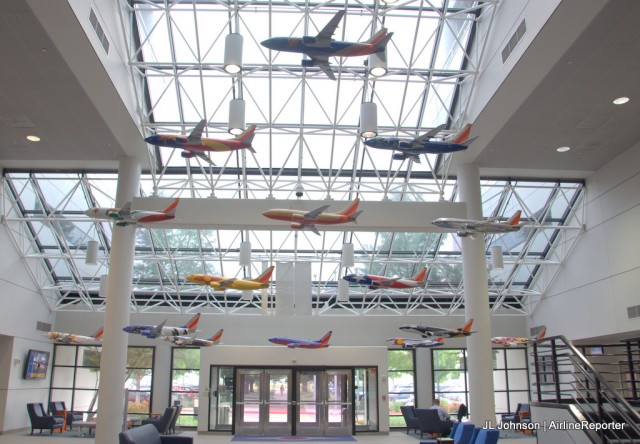
Large models illustrating Southwest’s special liveries hang in the atrium of the company’s HQ
For years I have connected at Dallas Love Field and peered across the aircraft operations area, staring at the home of Southwest Airlines, hoping to one day visit LUV HQ. In the effort of transparency, I’ve made little attempt to conceal my preference for the airline, and we’ll discuss why I think that they’re the best in a bit. But here’s a hint: It’s the culture.
I have a hand-full of friends who work for Southwest and follow a bunch of their employees on Instagram who occasionally post photos from the inside. My desire for a visit intensified when I became aware that the company had recently opened a large addition to their Dallas footprint, just across the street from their long-standing centralized DAL-based HQ. The building, affectionately known as TOPS (for Training and Operations Support), drastically expands the company’s capabilities and makes room for employees of the largest domestic airline to spread their wings.
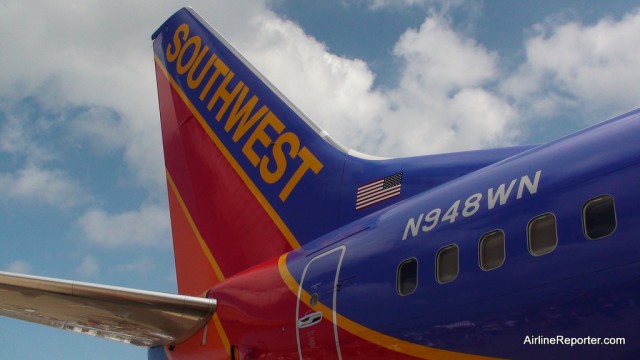
Southwest Airlines tail – Photo: David Parker Brown
After 12 years in corporate America, I have become a self-described boring, stodgy, business-type guy. I think that’s one of the reasons I am so attracted to Southwest’s culture. Because, it’s tough to not have a fun time around people who clearly enjoy their careers and are vested in the mission of their company.
On a recent late-night flight, an attendant came over the intercom to tell us they were turning down the lights and that we were welcome to turn on our overhead lighting. “If you want, push the button with a picture of a light bulb on it.” She continued, “However, pushing the button with the picture of a flight attendant on it will not turn on the flight attendant.”
It was late, we were all tired, and I think it’s fair to say the cabin had let their guard down. This unexpected bit of humor solicited a chuckle from me and a large portion of my 737-trekking peers. It’s these small, unexpected, fun experiences after a long draining day of meetings, charts, and presentations that I have come to rely upon as a part of my decompression ritual.
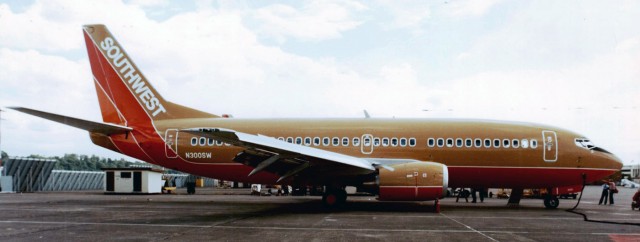
On November 30, 1984, Southwest took delivery of its first Boeing 737’“300, N300SW. It is now preserved at the Museum of Flight at Dallas Love Field. Photo: Boeing
Earlier this year, Southwest Airlines announced a significant number of new direct flights originating from their home base of Dallas Love Field. The newly-announced flights will provide non-stop service to places such as New York, Los Angeles, Denver, and Atlanta.
But why is Southwest, which has been in business since 1971, just now adding these seemingly universal routes to its network? To answer that question, we’ll have to go back in time and brush up on our Dallas-area airport history.
Prior to the opening of Dallas/Fort Worth International Airport (DFW) in 1974, the two cities had a history of contentious competition and missed opportunities. The first was a proposed joint airport way back in 1927. Fort Worth declined the proposal, opting to purchase and operate its own airport independent of Dallas. This led Dallas to build its own airport as well. The end result was the opening of both Love Field (in Dallas) and Meacham Field (in Fort Worth) to commercial air traffic.
In 1940, there was another attempt to cooperate in the construction of a regional airport for both cities, but it was eventually abandoned after neither city could agree on the location or details of the airport. This was followed by the creation of Amon Carter Field, later renamed to Greater Southwest International Airport (GSW), which was barely a stone’s throw away from Love Field.
Finally, in the early sixties, the FAA made it clear to the two cities that it wouldn’t invest any additional money into separate Dallas and Fort Worth airports (quick geography note ’“ downtown Dallas is roughly 30 miles from downtown Fort Worth). This, along with a directive from the Civil Aeronautics Board (CAB), finally pushed Dallas and Fort Worth together in an effort to develop a single large airport to serve the entire metroplex.
Thus, DFW was born.
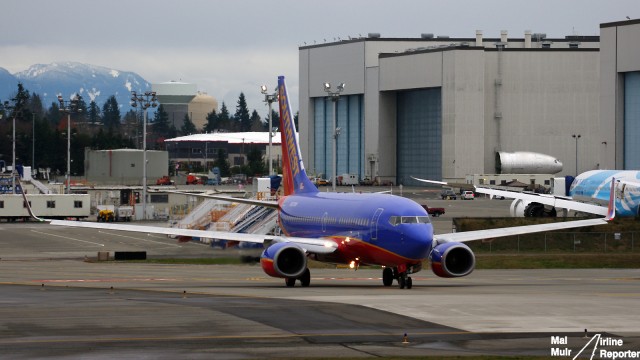
Southwest Boeing 737-700 taxing at KPAE
In the summer, my wife and I were planning a Christmas trip to Disneyland with our two toddlers (ages 2 and 4). We were looking to get out of cold Denver for the holidays, and had visited Disneyland in December a few years ago and thought all of the decorations were really cool. We decided to pull the trigger in late summer and I went work booking our travel.
I’m a very loyal United Airlines flyer, being Denver-based, and try to fly them exclusively. However, flights to the Los Angeles-area at Christmas, even months in advance, were ridiculously expensive. I’ve also recently come to grips with the fact that, having a newly-two-year-old daughter, four airline tickets really start to add up. So, I looked at the options on Southwest Airlines (WN) and was shocked – less than $200 round-trip for direct flights between Denver (DEN) and Orange County (SNA), which was less than half the cost of other options. I had never booked myself on WN, but couldn’t pass up the huge cost difference, especially for such a short flight. (Note – since I booked my “first” WN flights, I actually ended up flying on them to the Bahamas on a short-notice trip).
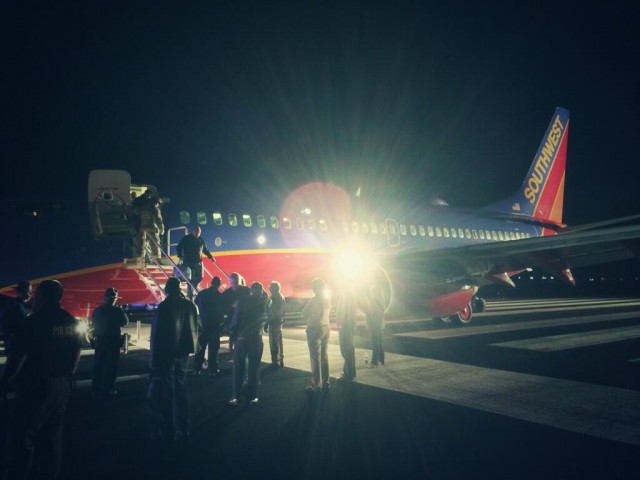
Photo of WN 3014, evacuated on the airfield at the wrong airport! – Photo: Scott Schieffer
Details are still coming in, but according to @scottDallasTX and other media sources, Southwest Flight 3014, from Chicago (Midway) landed at the wrong Branson, MO airport this evening (cause there are tons of Branson airports). Again, details are coming, but it appears they landed at the College of the Ozarks airport (PLK), with only a 3700′ runway. Does anybody know – is that long enough for a 737 t0 take off?
This is strangely reminiscent of the situation last month where a Boeing 747 Dreamlifter, operated by Atlas Air, landed at the wrong airport in Wichita. When fields are in close proximity, mistakes can happen.

Tweet from a passenger on WN 3014 – via Twitter
According to Scott, the landing was efficient, but scary.
More to follow!
Update (7:20PM PDT): It looks like the Southwest Boeing 737-700 CAN take off with this limited runway, albeit likely empty. Expecting a big day tomorrow for internet viewers? (H/T to Managing Correspondent @BigMalX).
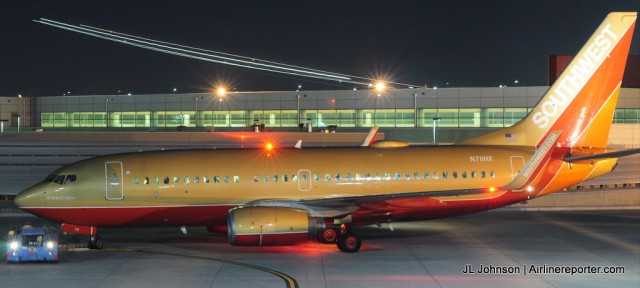
Southwest 737-700 (N711HK) seen at Dallas Love Field with Row 44 raydome between the strobe and vertical stabilizer. It also sports a retro-livery design.
On November 20, 2013 Southwest Airlines announced that, effective immediately, customers could use their portable electronic devices (PEDs) gate-to-gate. This was expected as other airlines had been making similar announcements earlier in the month after the FAA relaxed their rules. What wasn’t expected was that in-flight entertainment (IFE), through their Row 44 WiFi, would also be available gate-to-gate, making them the first U.S. airline to offer a seamless integrated experience, regardless of altitude.
Southwest Airlines has long been a renegade, going against the grain, often being successful with that strategy. When the industry zigs, they zag and usually find themselves with a competitive advantage. And that’s exactly what they did when they bucked the trend of U.S. airlines signing on with traditional passenger-level-hardware IFE. Instead, Southwest chose Row 44, an industry underdog to provide their connectivity. Row 44’s network is powered solely by satellite, whereas (at the time) the other big domestic players (i.e. GoGo) focused on terrestrial (land-based cell tower) service.
BONUS: GoGo Unveils New In-Flight Technology
I’m a known critic of IFE at the airline-provided-hardware level. I am of the school of thought that if you can give me WiFi, I’ll find a way to entertain myself, with my own device(s). BYOD (that is, “bring your own device”) is gaining in popularity across many industries and applications, so why not with airlines? Traditional IFE is expensive to implement, heavy to fly around, and requires added maintenance. With passengers likely to bring the added weight of their own devices anyway, why not simply eliminate the cost and complexity?
Southwest’s in-flight connectivity is nothing new, but has matured well beyond basic WiFi. I recently had the opportunity to try out the new gate-to-gate, or in my case, gate-to-gate-to-gate Row 44 on a business trip from Kansas City with a stopover at Dallas Love Field on my way to San Antonio. Let me say, I was impressed.






